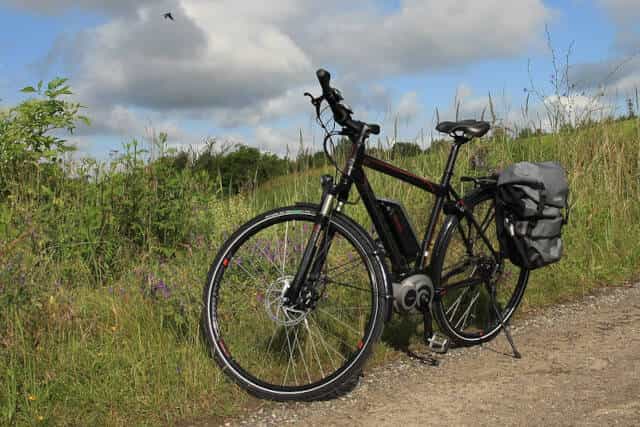Imagine hitting the open road on your electric bike, never having to worry about recharging it because the simple act of pedaling could generate enough power to keep your battery topped up.
It’s an enticing concept which sparks a lot of curiosity among bike enthusiasts. In theory, it seems logical that you could recharge an electric bike while going downhill or applying the brakes.
However, the reality is that most electric bikes currently on the market are not designed for this kind of energy regeneration.
Charging an electric bike through pedaling has been explored, but the technology falls short in practical implementation, as the power generated usually does not compensate for the loss in distance and speed.
As with any evolving technology, there’s potential for improvement in the future.
But for now, relying on traditional charging methods remains the most efficient way to keep your electric bike powered and ready for action.
Not All Electric Bikes Can Recharge While Pedaling
You’ve probably heard before that electric bikes can recharge while pedaling. That’s amazing, isn’t it? However, it’s a common misconception that all electric bikes have this ability to recharge their batteries.
In reality, this feature, known as regenerative braking or recharging, is available only on some e-bike models.
This ability comes in handy, as it helps to extend the battery life and enables more extended rides without the need for frequent recharging breaks.
However, it is essential to do your research before purchasing an electric bike to understand whether this feature is available or not, considering that not all e-bikes are designed the same.
While investing a little extra in a model with regenerative braking could be beneficial for certain riders, it is also crucial to know it can’t be a replacement for conventional E-bike charging.
In which you plug one end of your e-bike charger into a socket and the other into its charging port.
What Is Regenerative Braking for Ebikes?
Regenerative braking involves harnessing kinetic energy. The kinetic energy is then converted into electric energy, and then it is fed into the main traction battery.
Basically when you apply brakes in an electric bike with direct drive hub motor some of this energy ( about 5 to 10 % ) is captured and fed back into the battery.
However, you will find significantly fewer e-bikes in the market that use active regenerative braking.
Some e-bikes also allow the riders to charge by just peddling the e-bike in the backward direction. Also in several bikes, whenever you use the brake, the brake sensor is triggered to kick into reverse mode.
In this manner, the energy of the forward motion of the e-bike is utilized in charging its battery, this process is termed regenerative braking.
However, the problem with regenerative braking systems is it returns less power. On an average, it will take around 10 Kms of pedaling in order to give 1 Km charge (this justifies why charging by pedaling is not efficient.
We advise all riders to fully charge the bike’s battery once every few weeks so as to balance the cells.

Why is the Regenerative Braking System So Rare?
There are several reasons why regenerative braking systems are not commonly used in e-bikes. First of all, you should be aware that e-bikes that use regenerative braking systems offer tremendously less power.
In addition to this, there is no justifiable use-case for this braking system.
Also, regenerative brakes are considered impracticable for e-bikes (this can be attributed to the fact that the most practical drive variant for e-bikes is mid-drive.
Cycling 10 Kilometres to glean just one kilometre of charge may not seem like the most efficient way to power up – yet it can be a popular solution in future as more research happen in this field.
On the other hand, regenerative braking is more practically applicable in electric cars. So, overall, it’s not worthwhile to use such a braking system that offers minimal efficiency.
Why Don’t Electric Bikes charge When Going Downhill?
It’s a common query as to why electric bikes don’t charge when going downhill, especially when one considers the concept of regenerative braking which involves harnessing kinetic energy.
The primary reason behind this is that the electricity generated in such a process doesn’t compensate for the energy expended.
To produce a sufficient charge for the battery to regain power, a significant amount of friction is created, which subsequently slows down the bike.
This means that even when going downhill, you’d need to pedal quite rigorously. Which makes it impractical for actual use, no matter how good it looks on paper / in theory.
Companies Working on Self-Charging E-Bikes
The future of urban transportation is set to be revolutionized by the emergence of self-charging electric bicycle (e-bikes) that require little to no human effort.
A number of innovative companies are at the forefront of this cutting-edge development, driving the industry forward with their passion and expertise.
For instance, VELLO Bikes have been making waves with their unique folding e-bikes that can recharge as you ride, while Rayvolt X is gaining attention with its sleek design and regenerative braking system.
Furthermore, NUA Electrica is pushing the boundaries of e-bike innovation with its smart and minimalistic approach, boasting automatic transmission and energy recapture.
Additionally, Mokwheel’s high-end offering combines existing regenerative braking technologies with intelligent software for an unparalleled cycling experience.
And finally, Eahora Ebikes is doing all of the above for its future ebikes. They have some great plans but for now what the best they get is extra .43 miles for 6 miles of commute.

Could E-Bikes Charge Themselves in the Future?
The future of e-bikes holds immense potential, but there’s still a long road to travel before their self-charging capabilities are fully realized.
Skepticism surrounds the legitimacy of their self-charging potential, and the high costs of these advanced models have left many consumers feeling that the value for money is lacking.
Analysis of reviews and online discussions reveal concerns about affordability, with many e-bikes requiring a significant four-figure investment.
There’s also debate over whether the regenerative braking concept has been oversold, and if it can truly deliver on its promise.
Despite these challenges, hope remains high for the continued development of this innovative technology, with the possibility of self-charging e-bikes becoming a more viable option in the future.
Conclusion
So, we hope that we could clear many of your misconceptions, doubts, or queries related to e-bikes. Of-course, you now know very well that e-bikes make it easier to ride.
As mentioned earlier, if you love riding on hills or steep terrains, make note that e-bikes are appropriate for hilly regions. For e-bikes that come with motors rated at 2.5 kW or higher, a license will be needed.
Overall, whether rainy or sunny, water-resistant electric bikes are an excellent choice for riding in various conditions. If you have any doubts or suggestions related to this article, then please feel free to write it down in the comment section. Stay Tuned
Also Read,
How Much Does It Cost To Charge An Electric Bike
Critical Tips on How to Remove Speed Limiter E-Bike
Should I Buy an Electric Bicycle? Are Electric Bike Worth It









Leave a Reply